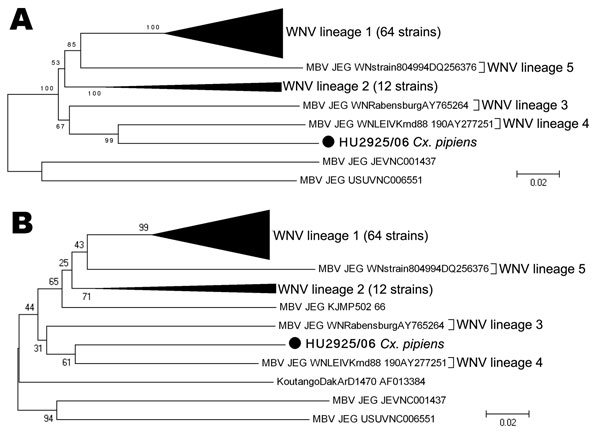Volume 16, Number 3—March 2010
Dispatch
Putative New Lineage of West Nile Virus, Spain
Figure

Figure. Phylogenetic tree of 79 WNV isolates by the neighbor-joining method and distance-p model on MEGA3.1 (www.megasoftware.net/mega_dos.html). Bootstrap values correspond to 1,000 replications. A) Analysis of a 1,813-nt fragment of the nonstructural protein 5 (NS5) gene. B) Analysis of the 800-nt fragment of the NS5 gene. KOUV (strain DakArD1470, AF013384) and Malaysia (strain KUN MP502–66, GU047874) (boldface) were also used to obtain this tree. Scale bars indicate nucleotide substitutions per site. WNV, West Nile virus; nt, nucleotide; MBV, mosquito-borne viruses; JEG, Japanese encephalitis group; JEV, Japanese encephalitis virus; USUV, Usutu virus. Viruses used in the phylogenetic study (GenBank accession nos.): WNV lineage 1 (AY712948, AY712947, AY490240, AY278442, AY278441, AY277252, AF404757, AF404756, AF404755, AF404754, AF404753, AF481864, AY603654, AY646354, AY289214, AY795965, AY842931, AY660002, AF196835, DQ164206, DQ164202, DQ164197, AF260969, AF260968, AF260967, DQ211652, DQ164204, DQ164200, DQ164201, AF533540, DQ005530, DQ118127, DQ164205, DQ164203, DQ164199, D00246, DQ164196, DQ080058, DQ080054, DQ080055, DQ080056, DQ164193, DQ164186, DQ164195, DQ164191, DQ164205, DQ080053, AY848696, AB185917, DQ080052, AB185914, DQ080051, DQ164189, AF404756, DQ164190, AY712945, AY712946, DQ080059, DQ164188, DQ164187, DQ164192, AF404757, AY277252, AY274505); WNV lineage 2 (DQ116961, DQ318019, M12294, EF429200, AY532665, EF429198, EF429199, EF429197, NC001563, AY688948, DQ176636, DQ318020); WNV lineage 3 (AY765264); WNV lineage 4 (AY277251); WNV lineage 5 (DQ256376); Spanish WNV (HU2925/06, GU047875); JEV: (NC001437); and USUV (NC006551) (as an outgroup).